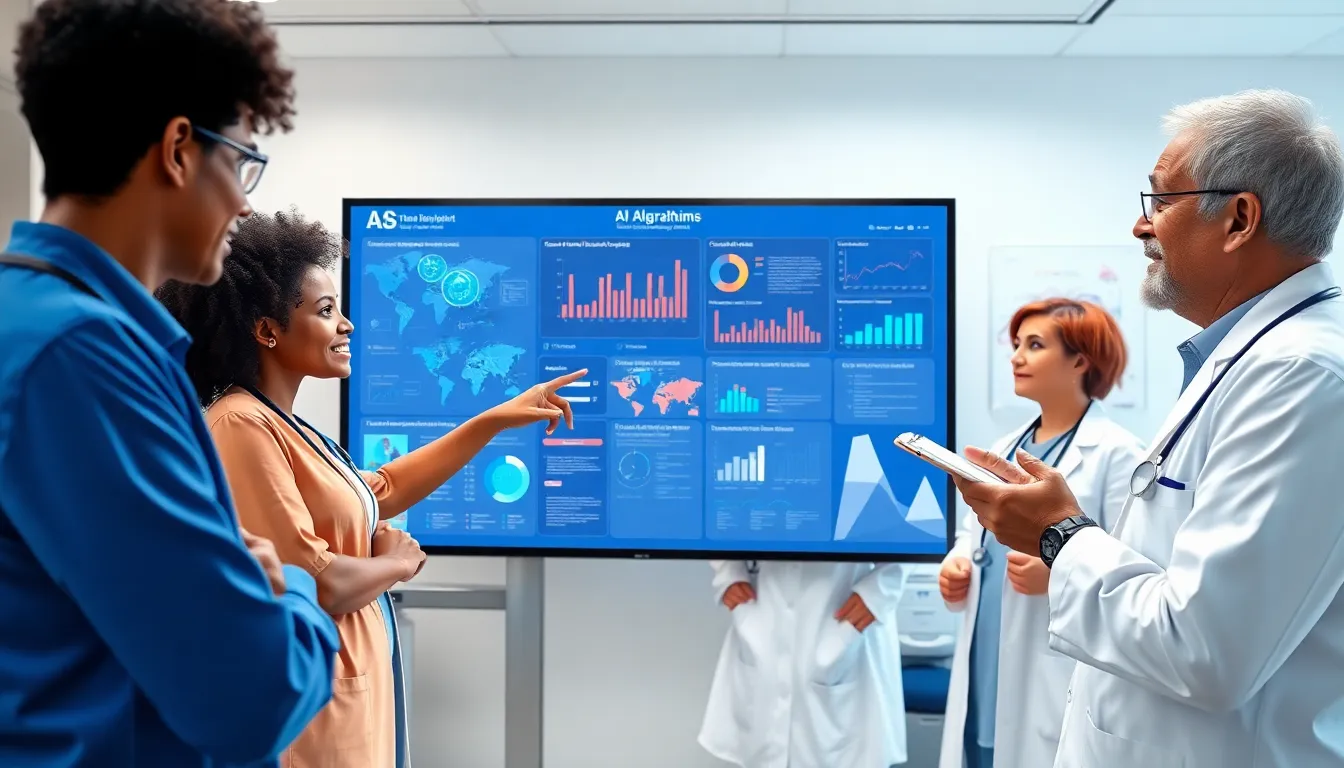The Internet of Things (IoT) isn’t just a buzzword; it’s transforming the way businesses operate. Imagine a world where your fridge orders milk before you even realize you’re out. Sounds like sci-fi, right? But in the realm of IoT, that’s just Tuesday. As more companies jump on the bandwagon, keeping up with the latest trends isn’t just smart—it’s essential.
From smart factories to connected cars, IoT is weaving its way into every industry, creating opportunities that are too good to ignore. Businesses that embrace these innovations are not only improving efficiency but also enhancing customer experiences. So, if you’re ready to dive into the future and discover how IoT can elevate your business game, buckle up! The trends are not just exciting; they’re downright game-changing.
Table of Contents
ToggleOverview of IoT Business Trends
Businesses increasingly recognize the integration of the Internet of Things (IoT) as a key driver in operational transformation. Smart devices proliferate, enabling real-time data collection and analysis across sectors. Enhanced connectivity leads to improved supply chain management, optimizing inventory accuracy and reducing operational costs.
Adoption rates show a consistent upward trajectory; 30% of organizations have implemented IoT solutions. Industries like healthcare adopt IoT for remote patient monitoring, improving care continuity and minimizing costs. Retailers increasingly utilize IoT technology for personalized shopping experiences, utilizing smart shelves and connected devices.
Significant growth is expected, with the global IoT market projected to reach $1.1 trillion by 2026. Security remains a critical concern, with companies prioritizing robust cybersecurity measures. Implementing end-to-end security protocols helps mitigate risks associated with connected devices.
The rise of edge computing increases the efficiency of IoT applications. Processing data closer to the source reduces latency, enabling businesses to respond swiftly to customer demands. Sustainability trends also heavily influence IoT adoption, with a focus on reducing carbon footprints and improving energy efficiency.
Furthermore, collaboration among businesses accelerates innovations in IoT ecosystems. Partnerships between technology providers and industry leaders create comprehensive solutions that enhance capabilities. Companies increasingly prioritize investing in skilled talent to manage IoT implementations effectively.
Collectively, these trends outline the necessity for organizations to adapt and evolve continuously. Staying updated with IoT advancements guarantees enhanced competitiveness and customer satisfaction.
Key Drivers of IoT Adoption

Technological advancements and market demand significantly drive IoT adoption across industries. Companies increasingly rely on innovative tools to stay competitive.
Technological Advancements
Edge computing capabilities enhance IoT efficiency by minimizing latency and optimizing data processing. Improved sensor technology allows devices to gather more accurate real-time data, enriching analytics. Wireless communication protocols evolve, promoting seamless connectivity between devices. Cloud computing resources enable scalable storage solutions for managing vast data volumes. Enhanced security features now protect sensitive information, addressing major concerns for businesses. Firms integrating these technologies realize substantial operational benefits.
Market Demand
Consumer expectations continually push businesses to adopt IoT solutions that enhance experiences. Increased interest in personalized services fuels demand in sectors like retail and healthcare. Data-driven insights drive companies to transform operations for greater efficiency. Competitive pressures compel organizations to meet the demands for automation and real-time analytics. The interest in sustainable practices influences IoT investments, focusing on energy efficiency. As a result, businesses actively seek innovative solutions to leverage growth potential.
Impact of IoT on Various Industries
The Internet of Things (IoT) significantly reshapes industries by enhancing operational efficiency and service delivery.
Healthcare
IoT technology revolutionizes healthcare by enabling remote patient monitoring and smart health devices. Hospitals utilize connected wearables to track vital signs in real-time, providing immediate insights into patient conditions. Approximately 30% of healthcare organizations have implemented IoT solutions, improving patient care outcomes. Devices like smart inhalers and blood glucose monitors enhance treatment adherence and personal health management. With the global market for IoT in healthcare projected to exceed $600 billion by 2024, providers are prioritizing data security and interoperability to safeguard sensitive information.
Manufacturing
Manufacturing experiences transformative effects from IoT through smart factories that optimize production processes. Industry leaders leverage connected machines for real-time monitoring and predictive maintenance. These advancements reduce downtime, enhance productivity, and lower costs. Approximately 30% of manufacturers now integrate IoT applications, driven by the need for greater efficiency and automation. IoT also facilitates supply chain visibility, enabling quick responses to market demands. The rise of edge computing further accelerates data processing, improving overall operational agility.
Retail
Retailers adopt IoT to enhance customer experiences and streamline operations. Smart shelves equipped with sensors provide inventory alerts in real-time, minimizing stockouts and overstock situations. Approximately 30% of retail businesses use IoT for personalized customer interactions, utilizing data analytics to tailor promotions. Connected devices also improve supply chain management by tracking goods from warehouses to store shelves. Retail IoT applications can increase sales by creating seamless, efficient shopping experiences, reflecting the growing consumer demand for convenient services.
Challenges Facing IoT Implementation
Implementing IoT solutions presents various challenges that organizations must navigate. Understanding these challenges is crucial for successful integration into business operations.
Security Concerns
Security remains a primary issue for IoT implementations. With 30% of organizations reporting IoT-related security incidents, safeguarding data and devices is essential. Hackers targeting unprotected devices expose sensitive information and disrupt operations. Companies must invest in robust cybersecurity measures to protect against breaches. Regular updates, strong authentication protocols, and data encryption can mitigate risks associated with vulnerabilities. As businesses enhance their IoT infrastructure, ensuring security won’t only protect assets but also build customer trust.
Interoperability Issues
Interoperability poses another significant challenge. Diverse device types and communication protocols complicate seamless interactions within IoT ecosystems. Manufacturers frequently create proprietary systems, leading to incompatibility issues. For instance, devices from different vendors may struggle to communicate, hindering data flow and operational efficiency. Standardization efforts are necessary to foster compatibility across devices and platforms. Emphasizing collaboration among stakeholders can lead to developing universal standards, making integration smoother and more effective for organizations.
Future Outlook of IoT Business Trends
The future of IoT business trends appears promising, especially as organizations increasingly integrate IoT solutions into their operations. By 2026, the global IoT market is set to reach $1.1 trillion, reflecting the growing significance of this technology across various sectors. Enhanced edge computing reduces latency, which plays a critical role in real-time data processing, enabling businesses to act on insights swiftly.
Healthcare stands out as a key area for innovation, as remote patient monitoring systems and smart health devices improve patient care outcomes. The market for IoT in healthcare is projected to exceed $600 billion by 2024, indicating strong demand for these technologies. Manufacturers are also adopting IoT to optimize production processes, with 30% of manufacturers already integrating IoT applications to enhance supply chain visibility.
Retailers utilize IoT to create smart shelves and deliver personalized customer experiences. Consumers increasingly expect convenience, driving demand for businesses to adopt IoT solutions to meet these expectations. The importance of data-driven insights cannot be overstated, as they encourage companies to invest in innovative IoT technologies.
Challenges related to security and interoperability persist, highlighting the need for robust cybersecurity measures. With 30% of organizations reporting IoT-related security incidents, companies prioritize implementing strong defenses to protect their assets. Interoperability issues complicate these integrations, as diverse devices can hinder seamless communication across IoT ecosystems.
Collaboration among stakeholders will be essential for developing universal standards, which can improve integration and operational efficiency. Investing in skilled talent is critical, as businesses require experts to navigate the complexities of IoT implementations. Embracing these trends ensures organizations remain competitive while enhancing customer satisfaction in an increasingly connected world.
The evolution of IoT is reshaping business landscapes across various sectors. Companies that embrace these trends are not just enhancing efficiency but also elevating customer experiences. The integration of smart technology is becoming crucial for staying competitive in a fast-paced market.
While challenges like security and interoperability persist, the focus on collaboration and innovation is paving the way for effective IoT solutions. As organizations invest in skilled talent and prioritize cybersecurity, they position themselves to thrive in this connected environment. The future of IoT holds immense potential for those ready to adapt and innovate.





